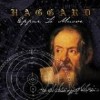Haggard, "Eppur Si Muove"
Drakkar
 Despite a rich history dictating otherwise, the average music listeneris likely to express shock or, depending on the snobbery of saidlistener, outrage at the idea that classical compositions andtraditional metal are perfect compliments to each other. For nearly twodecades, most of metal's finest have at one time or another employedthe services of forward thinking conductors (and vice versa, anyoneremember the ballet scored by Entombed?) or, at the very least, broughta keyboardist on board in the attempt to simulate a string section. Andthen there is Haggard, one of the largest "bands" on the planetclocking in at just fewer than 20 full-time, classically trainedmembers and a vast roster of recurrent guest musicians assembled tobring the two worlds together like no other. On Eppur Si Muove, thecollective's fourth full-length in ten years, founder and mastermindAsis Nasseri and company have once again managed to combineconventional Northern European folk, galloping melodic metal, andoperatic themes to extraordinary effect. To accommodate the Galileanmotif (which almost explains the absurd art), Italian imagery andbaroque orchestration are prevalent throughout the album. Theirdedication to this is such that some pieces are sung in Italian,bringing the languages represented to four, including the group'snative German, Latin, and English. While logic might dictate that theextensive ground which Haggard traverse over the course of one albumwould sacrifice cohesion, this couldn't be more from the truthconsidering this is a band that has made a career out of it. The firsttrack, "All´inizio è La Morte," is as good a demonstration of this asany. Opening with a Latin choral/classical arrangement and gruff Germanvocals, the song explores more placid territory before crunchy electricguitars and Asis' menacing growl are introduced, only to give way to asoaring Soprano and lush strings, all of which are brought back intothe mix for a climax rarely found in single eight minute tracks. Whileit would take far more space than provided here to explore theintricacies of each of the other eight tracks, suffice it to say thesame level of complexity exists throughout this juggernaut.
Despite a rich history dictating otherwise, the average music listeneris likely to express shock or, depending on the snobbery of saidlistener, outrage at the idea that classical compositions andtraditional metal are perfect compliments to each other. For nearly twodecades, most of metal's finest have at one time or another employedthe services of forward thinking conductors (and vice versa, anyoneremember the ballet scored by Entombed?) or, at the very least, broughta keyboardist on board in the attempt to simulate a string section. Andthen there is Haggard, one of the largest "bands" on the planetclocking in at just fewer than 20 full-time, classically trainedmembers and a vast roster of recurrent guest musicians assembled tobring the two worlds together like no other. On Eppur Si Muove, thecollective's fourth full-length in ten years, founder and mastermindAsis Nasseri and company have once again managed to combineconventional Northern European folk, galloping melodic metal, andoperatic themes to extraordinary effect. To accommodate the Galileanmotif (which almost explains the absurd art), Italian imagery andbaroque orchestration are prevalent throughout the album. Theirdedication to this is such that some pieces are sung in Italian,bringing the languages represented to four, including the group'snative German, Latin, and English. While logic might dictate that theextensive ground which Haggard traverse over the course of one albumwould sacrifice cohesion, this couldn't be more from the truthconsidering this is a band that has made a career out of it. The firsttrack, "All´inizio è La Morte," is as good a demonstration of this asany. Opening with a Latin choral/classical arrangement and gruff Germanvocals, the song explores more placid territory before crunchy electricguitars and Asis' menacing growl are introduced, only to give way to asoaring Soprano and lush strings, all of which are brought back intothe mix for a climax rarely found in single eight minute tracks. Whileit would take far more space than provided here to explore theintricacies of each of the other eight tracks, suffice it to say thesame level of complexity exists throughout this juggernaut.
 Despite a rich history dictating otherwise, the average music listeneris likely to express shock or, depending on the snobbery of saidlistener, outrage at the idea that classical compositions andtraditional metal are perfect compliments to each other. For nearly twodecades, most of metal's finest have at one time or another employedthe services of forward thinking conductors (and vice versa, anyoneremember the ballet scored by Entombed?) or, at the very least, broughta keyboardist on board in the attempt to simulate a string section. Andthen there is Haggard, one of the largest "bands" on the planetclocking in at just fewer than 20 full-time, classically trainedmembers and a vast roster of recurrent guest musicians assembled tobring the two worlds together like no other. On Eppur Si Muove, thecollective's fourth full-length in ten years, founder and mastermindAsis Nasseri and company have once again managed to combineconventional Northern European folk, galloping melodic metal, andoperatic themes to extraordinary effect. To accommodate the Galileanmotif (which almost explains the absurd art), Italian imagery andbaroque orchestration are prevalent throughout the album. Theirdedication to this is such that some pieces are sung in Italian,bringing the languages represented to four, including the group'snative German, Latin, and English. While logic might dictate that theextensive ground which Haggard traverse over the course of one albumwould sacrifice cohesion, this couldn't be more from the truthconsidering this is a band that has made a career out of it. The firsttrack, "All´inizio è La Morte," is as good a demonstration of this asany. Opening with a Latin choral/classical arrangement and gruff Germanvocals, the song explores more placid territory before crunchy electricguitars and Asis' menacing growl are introduced, only to give way to asoaring Soprano and lush strings, all of which are brought back intothe mix for a climax rarely found in single eight minute tracks. Whileit would take far more space than provided here to explore theintricacies of each of the other eight tracks, suffice it to say thesame level of complexity exists throughout this juggernaut.
Despite a rich history dictating otherwise, the average music listeneris likely to express shock or, depending on the snobbery of saidlistener, outrage at the idea that classical compositions andtraditional metal are perfect compliments to each other. For nearly twodecades, most of metal's finest have at one time or another employedthe services of forward thinking conductors (and vice versa, anyoneremember the ballet scored by Entombed?) or, at the very least, broughta keyboardist on board in the attempt to simulate a string section. Andthen there is Haggard, one of the largest "bands" on the planetclocking in at just fewer than 20 full-time, classically trainedmembers and a vast roster of recurrent guest musicians assembled tobring the two worlds together like no other. On Eppur Si Muove, thecollective's fourth full-length in ten years, founder and mastermindAsis Nasseri and company have once again managed to combineconventional Northern European folk, galloping melodic metal, andoperatic themes to extraordinary effect. To accommodate the Galileanmotif (which almost explains the absurd art), Italian imagery andbaroque orchestration are prevalent throughout the album. Theirdedication to this is such that some pieces are sung in Italian,bringing the languages represented to four, including the group'snative German, Latin, and English. While logic might dictate that theextensive ground which Haggard traverse over the course of one albumwould sacrifice cohesion, this couldn't be more from the truthconsidering this is a band that has made a career out of it. The firsttrack, "All´inizio è La Morte," is as good a demonstration of this asany. Opening with a Latin choral/classical arrangement and gruff Germanvocals, the song explores more placid territory before crunchy electricguitars and Asis' menacing growl are introduced, only to give way to asoaring Soprano and lush strings, all of which are brought back intothe mix for a climax rarely found in single eight minute tracks. Whileit would take far more space than provided here to explore theintricacies of each of the other eight tracks, suffice it to say thesame level of complexity exists throughout this juggernaut.



